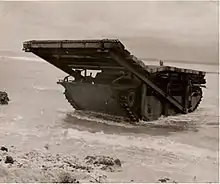18th Marine Regiment (United States)
The 18th Marine Regiment was a composite engineer regiment of the United States Marine Corps subordinate to the 2nd Marine Division. It was disbanded during the war, with the 1st and 2nd battalions remaining in the Division.[2]
| 18th Marine Regiment | |
|---|---|
 18th Marine Regiment insignia[1] | |
| Active | 18 September 1942 – 16 August 1944 |
| Country | |
| Branch | |
| Type | Engineer Regiment |
| Part of | 2nd Marine Division |
| Engagements | World War II |
Subordinate units
The regiment was a composite of three different types of battalions[3] and a headquarters and service company:
- 1st Battalion, A, B, & C Companies 2nd Engineer Battalion, now 2nd Combat Engineer Battalion
- 2nd Battalion, D, E, & F Companies 2nd Pioneer Battalion, now 2nd Landing Support Battalion
- 3rd Battalion, G, H, & I Companies 18th Naval Construction Battalion, now Naval Mobile Construction Battalion 18 or NMCB 18[4]
History
World War II

18th Marines was activated on 8 September 1942 and participated in actions at Tarawa, Saipan and Tinian. It was inactivated on 16 August 1944.[4]
On Tinian there were two small beaches on the North end where an assault landing could be made with low coral ledges.[5] The rest of the island had coral cliffs up to 15 feet in height at the waters edge negating any assault plans. However, the Marine Corps asked the Seabees if they could come up with an idea to get over the coral. Commodore Paul J. Halloran (CEC) CB theater commander provided drawings of a conceptual landing ramp for the 18th and 121st CBs to fabricate.[5] They mounted steel beams salvaged from Saipan's abandoned sugar mill on LVT-2s to create a portable assault ramps. If they worked they would allow the Marines to outflank Tinian's prepared defenses. The Marine Generals was skeptical and ordered that the ramps be put through a 100 vehicle use tests. The Seabee creation was named a Doodlebug.[5] It worked exactly as the Marines had hoped.[5]
Commanders
- Colonel Elmer E. Hall: 8 September 1942
- Colonel Ewart S. Laue: 31 August - 3 October 1943; 24–29 February 1944; 7–9 April 1944; 22–24 April 1944
- Colonel Cyril W. Martyr: 4 October 1943 - 23 February 1944; 1 March - 6 April 1944; 25 June - 15 August 1944
- LtCol Russell Lloyd: 10–14, 19–21, 25–30 April 1944; 1–11 May 1944; 1–24 June 1944[4]
Unit awards
![]() Presidential Unit Citation with blue enamel star : – Tarawa
Presidential Unit Citation with blue enamel star : – Tarawa
- 1st Battalion
- 2d Battalion[6]
See also
References
- 18th Naval Construction Battalion history, Seabee Museum, Port Hueneme, CA 93043. p.70
- U.S. Marine Corps World War II Order of Battle Fleet Marine Force Ground Units, Rottman p. 220
- Battle Orders - US Marine Corps Pacific Theater of Operations 1943-44, Gordon L Rottman, Osprey Publishing, p. 13
- Rottman, Gordon L. (2002). US Marine Corps World War II order of battle : ground and air units in the Pacific War, 1939–1945, p. 218 (1 ed.). Westport, Connecticut: Greenwood Press. pp. 218–220. ISBN 9780313319068.
- The Doodlebug, Naval History and Heritage Command, U.S. Navy Seabee Museum webpage, Port Hueneme, Ca,
- NAVMC 2922 of 7 May 2012, DEPARTMENT OF THE NAVY, HEADQUARTERS UNITED STATES MARINE CORPS, 2008 ELLIOT ROAD, QUANTICO, VIRGINIA 22134-5030 Archived 2018-07-30 at the Wayback Machine
External links
- http://www.tarawaontheweb.org/leather.htm
- http://www.ibiblio.net/hyperwar/USMC/USMC-M-Saipan/USMC-M-Saipan-IV.html%5B%5D
- http://www.ibiblio.org/hyperwar/USMC/USMC-M-Tinian/USMC-M-Tinian-IV.html
- http://www.ibiblio.org/hyperwar/USMC/USMC-M-Tarawa/USMC-M-Tarawa-H.html
- https://www.ibiblio.org/hyperwar/USMC/USMC-M-Tarawa/index.html#index
- http://www.seabeecook.com/history/NMCB_18.htm

